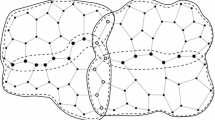Abstract
We address the problem of designing compact data structures for encoding a Triangulated Irregular Network (TIN). In particular, we study the problem of compressing connectivity, i.e., the information describing the topological structure of the TIN, and we propose two new compression methods which have different purposes. The goal of the first method is to minimize the number of bits needed to encode connectivity information: it encodes each vertex once, and at most two bits of connectivity information for each edge of a TIN; algorithms for coding and decoding the corresponding bitstream are simple and efficient. A practical evaluation shows compression rates of about 4.2 bits per vertex, which are comparable with those achieved by more complex methods. The second method compresses a TIN at progressive levels of detail and it is based on a strategy which iteratively removes a vertex from a TIN according to an error-based criterion. Encoding and decoding algorithms are presented and compared with other approaches to progressive compression. Our method can encode more general types of triangulations, such as those constrained by topographic features, at the cost of a slightly longer bitstream.
Similar content being viewed by others
References
R. Bar-Yehuda and C. Gotsman. “Time/space tradeoffs for polygon mesh rendering,” ACM Transactions on Graphics, Vol. 15(2):141–152, 1996.
H. Bruggeser and P. Mani. “Shellable decompositions of cells and spheres,” Math. Scand., Vol. 29:197–205, 1971.
M.M. Chow. Optimized geometry compression for real-time rendering, in R. Yagel and H. Hagen, editors, IEEE Visualization '97 Proceedings, 347–354, IEEE Press, 1997.
M. de Berg, R. van Kreveld, R. van Oostrum, and M. Overmars. “Simple traversal of a subdivision without extra storage,” International Journal of Geographic Information Science, Vol. 11:1997.
L. De Floriani, P. Magillo, and E. Puppo. “Building and traversing a surface at variable resolution,” in Proceedings IEEE Visualization 97, 103–110, Phoenix, AZ (USA), 1997.
L. De Floriani, P. Magillo, and E. Puppo. “VARIANT—processing and visualizing terrains at variable resolution,” in Proceedings 5th ACM Workshop on Advances in Geographic Information Systems, Las Vegas, Nevada, 1997.
L. De Floriani, P. Magillo, and E. Puppo. “Compressing TINs,” in Proceedings 6th ACM Workshop on Advances in Geographic Information Systems, 1998.
M. Deering. “Geometry compression,” in Comp. Graph. Proc., Annual Conf. Series (SIGGRAPH '95), ACM Press, 13–20, 1995.
F. Evans, S. Skiena, and A. Varshney. “Optimizing triangle strips for fast rendering,” in Proceedings IEEE Visualization '96, 319–326, 1996.
L.J. Guibas, D.E. Knuth, and M. Sharir. “Randomized incremental construction of the Delaunay and Voronoi diagrams,” Algorithmica, Vol. 7:381–413, 1992.
P. Heckbert and M. Garland. Survey of surface simplification algorithms. Technical Report, Department of Computer Science, Carnegie Mellon University, 1997.
H. Hoppe. “Progressive meshes,” in ACM Computer Graphics Proc., Annual Conference Series, (SIGGRAPH '96), 99–108, 1996.
H. Hoppe. “Efficient implementation of progressive meshes,” Computers & Graphics, Vol. 22:27–36, 1998.
J. Lee. “A drop heuristic conversion method for extracting irregular networks from digital elevation models,” in Proceedings GIS/LIS'89, 30–39, Orlando, FL, USA, 1989.
P. Magillo. Spatial Operations on Multiresolution Cell Complexes. Ph.D. Thesis, Dept. of Computer and Information Sciences, University of Genova (Italy), 1999.
B.P. Pennbaker and J.L. Mitchell. JPEG, Still image compression standard. Van Nostrand Reinhold, 1993.
J. Snoeyink and M. van Kreveld. “Linear-time reconstruction of Delaunay triangulations with applications,” in Proc. 5th European Symposium on Algorithms, 1997.
G. Taubin and J. Rossignac. “Geometric compression through topological surgery,” ACM Transactions on Graphics, Vol. 17(2):84–115, 1998.
C. Touma and C. Gotsman. “Triangle mesh compression,” in Proceedings Graphics Interface'98, 26–34, 1998.
Author information
Authors and Affiliations
Rights and permissions
About this article
Cite this article
Floriani, L.D., Magillo, P. & Puppo, E. Compressing Triangulated Irregular Networks. GeoInformatica 4, 67–88 (2000). https://doi.org/10.1023/A:1009880409451
Issue Date:
DOI: https://doi.org/10.1023/A:1009880409451




